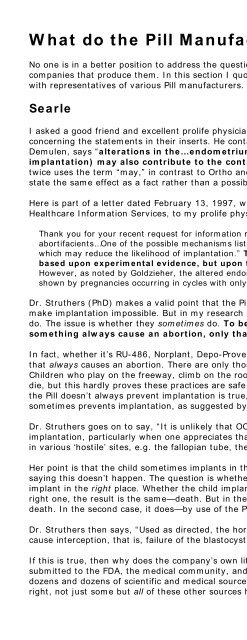Does the Birth Control Pill Cause Abortions
Does the Birth Control Pill Cause Abortions
Does the Birth Control Pill Cause Abortions
Create successful ePaper yourself
Turn your PDF publications into a flip-book with our unique Google optimized e-Paper software.
What do <strong>the</strong> <strong>Pill</strong> Manufacturers Say<br />
No one is in a better position to address <strong>the</strong> question of how birth control pills work than <strong>the</strong><br />
companies that produce <strong>the</strong>m. In this section I quote from <strong>the</strong>ir materials and recount conversations<br />
with representatives of various <strong>Pill</strong> manufacturers.<br />
Searle<br />
I asked a good friend and excellent prolife physician to call a birth control pill manufacturer<br />
concerning <strong>the</strong> statements in <strong>the</strong>ir inserts. He contacted Searle, whose package insert for <strong>the</strong> pill<br />
Demulen, says “alterations in <strong>the</strong>…endometrium (which may reduce <strong>the</strong> likelihood of<br />
implantation) may also contribute to <strong>the</strong> contraceptive effectiveness.” (Note that Searle<br />
twice uses <strong>the</strong> term “may,” in contrast to Ortho and Wyeth, which in <strong>the</strong>ir information in <strong>the</strong> PDR<br />
state <strong>the</strong> same effect as a fact ra<strong>the</strong>r than a possibility.)<br />
Here is part of a letter dated February 13, 1997, written by Barbara Stru<strong>the</strong>rs, Searle’s Director of<br />
Healthcare Information Services, to my prolife physician friend:<br />
Thank you for your recent request for information regarding whe<strong>the</strong>r oral contraceptives are<br />
abortifacients…One of <strong>the</strong> possible mechanisms listed in <strong>the</strong> labeling is “changes in <strong>the</strong> endometrium<br />
which may reduce <strong>the</strong> likelihood of implantation.” This is a <strong>the</strong>oretical mechanism only and is not<br />
based upon experimental evidence, but upon <strong>the</strong> histologic appearance of <strong>the</strong> endometrium.<br />
However, as noted by Goldzieher, <strong>the</strong> altered endometrium is still capable of sustaining nidation, as<br />
shown by pregnancies occurring in cycles with only a few or no tablet omissions. 58<br />
Dr. Stru<strong>the</strong>rs (PhD) makes a valid point that <strong>the</strong> <strong>Pill</strong>’s effects on <strong>the</strong> endometrium do not always<br />
make implantation impossible. But in my research I’ve never found anyone who claims <strong>the</strong>y always<br />
do. The issue is whe<strong>the</strong>r <strong>the</strong>y sometimes do. To be an abortifacient does not require that<br />
something always cause an abortion, only that it sometimes does.<br />
In fact, whe<strong>the</strong>r it’s RU-486, Norplant, Depo-Provera, <strong>the</strong> Mini-pill or <strong>the</strong> <strong>Pill</strong>, <strong>the</strong>re is no chemical<br />
that always causes an abortion. There are only those that do so never, sometimes, often and usually.<br />
Children who play on <strong>the</strong> freeway, climb on <strong>the</strong> roof or are left alone by swimming pools don’t always<br />
die, but this hardly proves <strong>the</strong>se practices are safe and never result in fatalities. Thus, <strong>the</strong> point that<br />
<strong>the</strong> <strong>Pill</strong> doesn’t always prevent implantation is true, but has no bearing on <strong>the</strong> question of whe<strong>the</strong>r it<br />
sometimes prevents implantation, as suggested by Searle’s own literature.<br />
Dr. Stru<strong>the</strong>rs goes on to say, “It is unlikely that OCs would decrease <strong>the</strong> likelihood of endometrial<br />
implantation, particularly when one appreciates that <strong>the</strong> blastocyst is perfectly capable of implanting<br />
in various ‘hostile’ sites, e.g. <strong>the</strong> fallopian tube, <strong>the</strong> ovary, <strong>the</strong> peritoneum.”<br />
Her point is that <strong>the</strong> child sometimes implants in <strong>the</strong> wrong place. True enough—but, again, no one is<br />
saying this doesn’t happen. The question is whe<strong>the</strong>r <strong>the</strong> <strong>Pill</strong> sometimes hinders <strong>the</strong> child’s ability to<br />
implant in <strong>the</strong> right place. Whe<strong>the</strong>r <strong>the</strong> child implants in <strong>the</strong> wrong place or fails to implant in <strong>the</strong><br />
right one, <strong>the</strong> result is <strong>the</strong> same—death. But in <strong>the</strong> first case a human agent does not cause <strong>the</strong><br />
death. In <strong>the</strong> second case, it does—by use of <strong>the</strong> <strong>Pill</strong>.<br />
Dr. Stru<strong>the</strong>rs <strong>the</strong>n says, “Used as directed, <strong>the</strong> hormone level in modern OCs is simply too low to<br />
cause interception, that is, failure of <strong>the</strong> blastocyst to implant.”<br />
If this is true, <strong>the</strong>n why does <strong>the</strong> company’s own literature—produced by <strong>the</strong>ir researchers and<br />
submitted to <strong>the</strong> FDA, <strong>the</strong> medical community, and <strong>the</strong> public—suggest <strong>the</strong> contrary And why do<br />
dozens and dozens of scientific and medical sources definitively state <strong>the</strong> contrary If Dr. Stru<strong>the</strong>rs is<br />
right, not just some but all of <strong>the</strong>se o<strong>the</strong>r sources have to be wrong.



